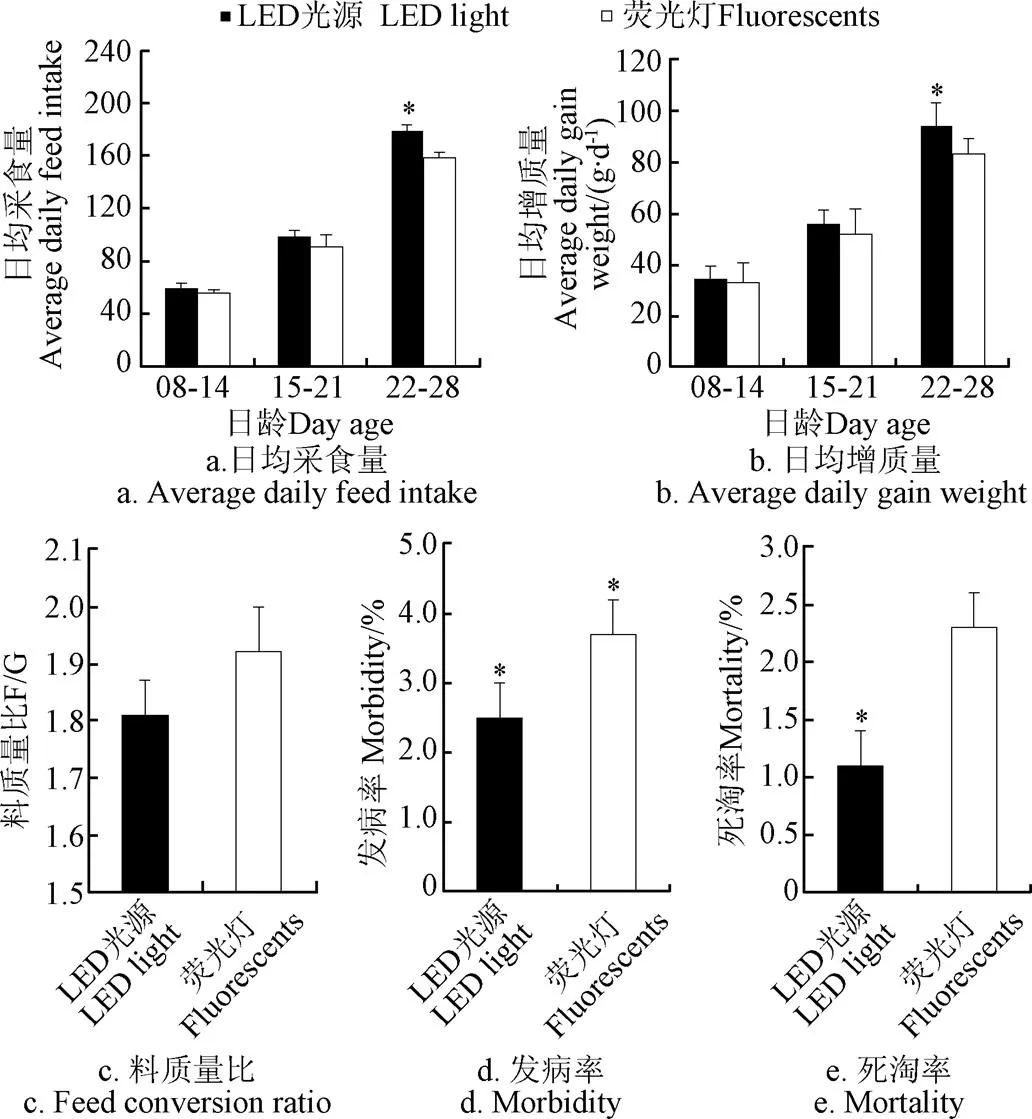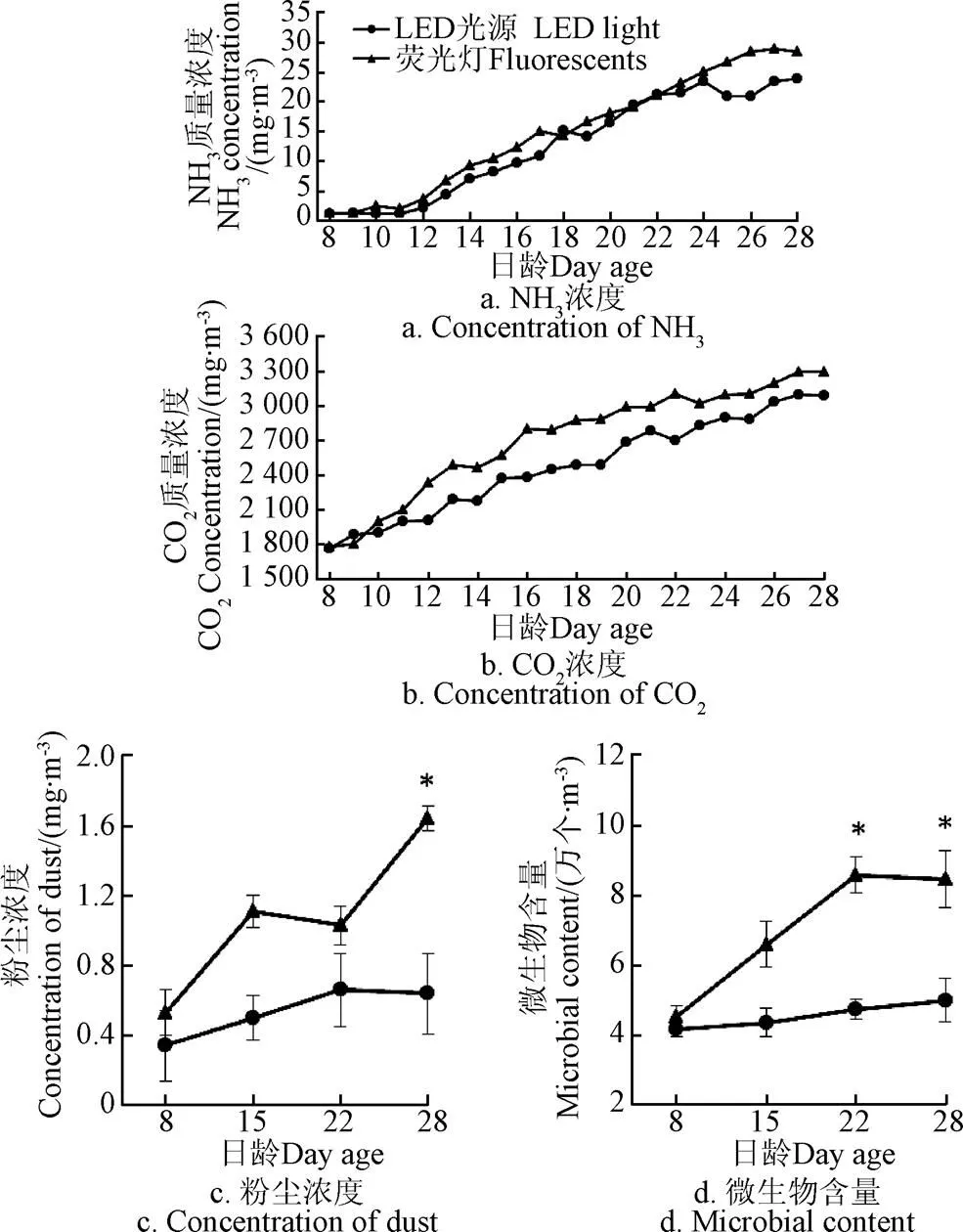LED光源改善鸡舍环境及肉鸡生产性能
石志芳,席 磊,姬真真,程 璞
LED光源改善鸡舍环境及肉鸡生产性能
石志芳1,席 磊2※,姬真真2,程 璞1
(1. 河南牧业经济学院动物科技学院,郑州 450046; 2. 河南牧业经济学院 自动化学院,郑州 450046)
探讨全封闭饲养条件下,LED光源对肉鸡生产性能,养分表观消化率和鸡舍空气中NH3、CO2、粉尘浓度,以及空气微生物含量的影响。试验于2017年3月2日至3月30日在河南省某农业集团一大型肉鸡场进行。选用健康状况良好、体况一致的1日龄白羽肉鸡240只,采用单因子完全随机试验设计,分为2个处理组,一组采用暖白色光LED灯光源照明为试验组,另一组采用普通暖白色荧光灯光源照明为对照组。试验期间详细观察肉鸡生产情况,分别计算平均日采食量、平均日增质量、料质量比、发病率以及死淘率。于肉鸡8、15、22和28日龄当日全收粪法测定粗蛋白、粗脂肪、钙和磷的表观消化率。试验期间每天08:00,14:00和20:00,采用光化学方法分别在两栋鸡舍内测量NH3和CO2浓度,测量点分布依据五点法,测量高度为0.5 m。分别对8、15、22和28日龄的鸡舍,采用质量法测定粉尘含量,平板沉降法测定空气微生物含量。结果表明,与荧光灯相比,LED光源对8~22日龄肉鸡的生产性能、养分代谢及其生存环境质量没有不利影响。LED光源有利于提高22~28日龄肉鸡的平均日采食量和平均日增质量,分别比荧光灯光源下的肉鸡显著增加了13.13%和13.23%(<0.05)。LED光源有利于提高22~28日龄肉鸡对饲料中粗蛋白,钙和磷的表观消化率,22日龄时,分别比荧光灯鸡舍的肉鸡显著提高了9.45%,14.90%和7.48%(<0.05),28日龄时分别提高了7.30%,6.78%和8.29%(<0.05)。试验期间LED光源鸡舍内肉鸡发病率为2.45%,显著低于荧光灯鸡舍3.57%的发病率(<0.05)。LED光源鸡舍内肉鸡死淘率为1.18%,显著低于荧光灯鸡舍2.36%的死淘率(<0.05)。同时,LED光源鸡舍的25日龄以后的NH3浓度、22日龄以后的粉尘和微生物浓度均显著低于荧光灯光源鸡舍(<0.05)。因此,LED光源有利提高肉鸡的生产性能和改善肉鸡生活空间的空气环境质量,加之LED光源在养殖生产上的应用具有安全、经济、环保的特点,值得进一步推广和应用。
光;养分;环境质量控制;LED光源;密闭式肉鸡舍;白羽肉鸡;生产性能;表观消化率
0 引 言
中国是肉鸡养殖大国,2016年肉鸡总出栏量82.1亿只,鸡肉总产量1 244万t[1],仅次于美国,位居世界第二。鸡是一种对光十分敏感的动物,光刺激可以通过视网膜上的光受体产生光信号,也可以直接通过颅骨刺激视网膜外光受体产生神经冲动,刺激下丘脑分泌促性腺激素释放激素,作用于垂体前叶进而控制和调节禽类体内激素的分泌,从而影响它们的行为、节律,对禽类的生长、健康以及性成熟有重要的影响[2-4]。现代养鸡生产中可通过人工干预光照提高肉鸡生产效率。20世纪末期以来,研究人员已就不同光源影响商品肉鸡的生长发育进行了大量研究。研究发现,白炽灯、暖白荧光灯、金属卤素灯和高压钠灯等光源会不同程度影响肉鸡的行为和生产性能[5-6]。目前,肉鸡生产中普遍采用白炽灯、荧光灯等传统光源,但其发光效率低、存在频闪等问题,不仅耗能大,而且对鸡的健康也存在着潜在风险,从而影响了养鸡生产的经济效益,无法满足现代化肉鸡养殖的需求。近年来,随着LED照明技术的发展,其发光效率高、耗能低、容易根据用光特点个性化定制等优点,在肉鸡养殖中越来越受到重视。研究发现,使用LED灯作为光源可以提高肉鸡孵化率,提高雏鸡品质,降低肉鸡生长过程中的应激反应[7-8],增强小肠黏膜结构和免疫屏障[9]和改善鸡肉品质[10]。已有研究证明,LED光源通过不同光色和光照时间的调节在肉鸡生产过程中对肉鸡的生长、行为、鸡肉的品质以及免疫等方面起到积极的作用[11-18]。但对LED光源对于肉鸡养分表观消化率,以及LED光源对于鸡舍内NH3浓度、CO2浓度、粉尘浓度、空气微生物含量的影响却少见报道,本文通过研究LED 光源和普通荧光灯光源下2栋密闭式肉鸡舍内8~28日龄肉鸡生产性能和养分表观消化率差别,以及鸡舍空气环境中NH3浓度、CO2浓度、粉尘浓度、空气微生物含量的差异和变化趋势,为LED光源在肉鸡养殖生产中的应用提供依据。
1 材料与方法
1.1 试验动物与方法
选用健康状况良好、体况一致的1日龄白羽肉鸡240只,采用单因子完全随机试验设计,分为2个处理组,一组采用暖白色光(3 000 K)LED灯光源照明为试验组,另一组采用普通暖白色(2 900 K)荧光灯光源照明为对照组。每个处理组内设4个重复,每个重复30只。试验于2017年3月2日至3月30日在河南省某农业集团大型肉鸡场进行(图1)。试验鸡舍和对照鸡舍均为东西走向,长×宽×高均为180 m×18 m×3.5 m,采用地面平养方式,机械通风,自由采食和饮水,均采用1~3 日龄光照时间24 h、光照强度约为16~22 lx,平均为(19±3)lx,4日龄后每天光照时间18 h、光照强度为8~12 lx,平均为(10±2)lx的光照制度。

图1 试验区位在鸡舍的平面分布及光照强度测量点位示意图
1.2 日粮组成及营养水平
采用玉米-豆粕型基础日粮,参照白羽肉仔鸡营养需要进行配制,基础日粮组成及营养水平见表1。

表1 肉鸡基础日粮组成及营养水平
1.3 测定指标与方法
1.3.1 生长性能测定
分别于7、14、21、28日龄08:00时开始停止供料,不停止饮水,使各处理组肉鸡空腹24 h后,于8、15、22、29日龄8:00逐只称质量,以各重复组为单位分别计算试验组、对照组的肉鸡平均体质量。准确记录试验期内每天的饲料消耗量,当肉鸡出现死淘情况时及时截料称质量,计算总耗料量。试验期间详细观察肉鸡生产情况,记录发病鸡只和死淘鸡只数量。采用下列公式分别计算平均日采食量、平均日增质量、料质量比、发病率以及死淘率。
平均日采食量=总耗料量/(只数×天数);
平均日增质量=总增质量/(只数×天数);
料质量比=总耗料量/总增质量;
发病率(%)=病鸡数/入栏总鸡数×100%;
死淘率(%)=死鸡数/入栏总鸡数×100%。
1.3.2 饲料表观消化率测定
采集肉鸡饲料和粪便样品。供试肉鸡的粪便样品采用全收粪法,分别于试验开始后的第6、13、20和27天以重复组为单位收集各处理组肉鸡粪便,收集时注意将粪中的羽毛皮屑及散落在粪便表面的饲料剔除干净,称取鲜粪质量,然后放入120 ℃鼓风干燥箱内24 h后,置于室温下24 h回潮,称质量并记录。用粉碎机粉碎后,过40目筛备用。按文献[19]的方法分别测定饲料和粪样中的粗蛋白、粗脂肪、钙、磷的含量,利用下述公式计算粗蛋白、粗脂肪、钙、磷的表观消化率。

1.3.3 鸡舍环境参数测定
肉鸡舍各环境参数均采用五点梅花布点方式进行。于试验期间每天08:00、14:00和20:00 3个时间点,采用GASTiger2000型NH3和CO2便携式测量仪,测定距地面约0.5 m高度上空气环境的NH3和CO2浓度;鸡舍粉尘浓度为每天12:00时利用FLY-3R25型大气粉尘采样器,采用质量法测定,计算公式如下
式中为总粉尘总浓度,mg/m3;1为采样前滤膜质量,mg;2为采样后滤膜质量,mg;为采样流量,L/min;为采样时间,min。
鸡舍微生物浓度采用平板沉降法,分别测定第8、15、22和28天的鸡舍空气微生物含量。采样高度0.5 m,采样时间10 min,采样结束后盖上平板盖,编号,将平板倒置于37 ℃下培养箱内24 h后进行菌落计数,按下式计算空气中微生物总菌落数(CFU/m3):

式中为培养皿面积,cm2;为采样时间,min;为每个培养皿内菌落数,CFU。
1.4 主要仪器
GASTiger2000型NH3和CO2便携式测量仪(深圳万安迪科技有限公司);FLY-3R25型大气粉尘采样器(北京宏昌信仪器设备公司);LGR-WSD20型温湿度记录仪(杭州路格科技有限公司);303A-4型数显电热培养箱(上海荣丰科学仪器有限公司)。
1.5 数据处理与分析
试验数据用SPSS 23.0进行单因素方差分析,结果以“平均值±标准差”表示,以<0.05表示差异显著。
2 结果与分析
2.1 LED光源对肉鸡生产性能的影响
LED光源对肉鸡平均日采食量、平均日增质量、发病率及死淘率的影响见图2。

注:*表示2处理之间差异显著P<0.05,下同。
由图2a可知,21日龄前,2种光源照明的鸡舍中饲养的肉鸡平均日采食量没有明显差异(>0.05)。(8~14日龄,LED光源和荧光灯光源肉鸡采食量分别为59.51和55.77 g/d,无明显差异,而22~28日龄期间,LED光源鸡舍的肉鸡平均日采食量为178.83 g/d,比荧光灯光源鸡舍的肉鸡平均日采食量显著增加了13.13%(<0.05)。由图2b可知,21日龄前,2种光源照明的鸡舍中饲养的肉鸡平均日增质量没有明显差异(>0.05)。而22~28日龄期间,LED光源鸡舍的肉鸡平均日增质量为93.79 g/d,比荧光灯光源鸡舍的肉鸡平均日增质量显著提高了13.23%(<0.05)。由图2c可知,试验期间内不同光源2栋肉鸡舍内料质量比平均值分别为1.82和1.91,不存在显著差异,更长期间内的影响有待进一步研究。由图2d可知,试验期间LED光源鸡舍内肉鸡发病率为2.45%,显著低于荧光灯鸡舍3.57%的发病率(<0.05)。由图2e可知,LED光源鸡舍内肉鸡死淘率为1.18%,显著低于荧光灯鸡舍2.36%的死淘率(<0.05)。说明在肉鸡饲养的前期(21日龄前),与荧光灯相比,LED光源照明对肉鸡的平均日采食量和平均日增质量没有影响,而在饲养后期即21日龄后,LED光源照明可以显著提高肉鸡平均日采食量和平均日增质量。同时也可以提高肉鸡健康,降低发病率和死淘率。
2.2 LED光源对肉鸡养分表观消化率的影响
LED光源对肉鸡饲料养分表观消化率的影响见图3。由图3a、3c和3d可知,8日龄和15日龄时,与荧光灯光源鸡舍相比,LED光源鸡舍的肉鸡对饲料中粗蛋白、钙和磷的表观消化率没有显著影响(>0.05)。随着肉鸡日龄的增加,2种光源对肉鸡饲料养分表观消化率的影响逐渐表现出差异,到22日龄,LED光源鸡舍的肉鸡对饲料中粗蛋白、钙和磷的表观消化率分别比荧光灯鸡舍的肉鸡显著提高了9.45%,14.90%和7.48%(<0.05)。28日龄时LED光源鸡舍的肉鸡对饲料中粗蛋白、钙和磷的表观消化率分别比荧光灯鸡舍肉鸡显著提高7.30%,6.78%和8.29%(<0.05)。整体试验期间,2种光源鸡舍的肉鸡对饲料中粗脂肪的表观消化率没有显著差异(>0.05)。

图3 LED光源对肉鸡养分表观消化率的影响
2.3 LED光源对肉鸡舍内空气环境的影响
LED光源对肉鸡舍内空气环境的影响见图4。由图4a可知,使用LED灯作为光源的鸡舍内NH3浓度整体低于使用荧光灯作为光源的鸡舍。8~11日龄期间,白羽肉鸡的日龄比较小,体格也比较小,排泄的粪尿也比较少,而且这个阶段的垫料干燥,NH3产生的来源少,NH3浓度相对较低,LED光源鸡舍与荧光灯鸡舍内NH3浓度基本保持在一个低的水平。随着肉鸡日龄的增加,鸡体质量的增大,排泄增多,粪尿积累,2种光源鸡舍内的NH3浓度亦呈现出增加趋势,即从12日龄开始,2种光源鸡舍内的NH3浓度明显呈现出快速上升的态势。25日龄后,LED光源鸡舍内NH3浓度呈现稍有下降,明显低于荧光灯光源鸡舍的NH3浓度(<0.05)。由图4b可知,随着肉鸡日龄的增加,2种光源鸡舍内的CO2浓度均呈现升高趋势,但LED光源鸡舍内CO2浓度明显低于荧光灯光源鸡舍内CO2浓度(<0.05)。由图4c、4d可以看出,随着肉鸡日龄的增加,肉鸡排泄量和活动量的增多,2种光源鸡舍的粉尘和微生物含量亦均呈现上升趋势。但在22日龄前,2种光源鸡舍粉尘和微生物浓度均无明显差别(>0.05),22日龄以后,LED光源鸡舍内的粉尘和微生物浓度均显著低于荧光灯光源鸡舍,分别比荧光灯光源鸡舍显著降低了48.5%和47.1%(<0.05)。

图4 LED光源对肉鸡舍内环境参数的影响
3 讨 论
3.1 LED光源对肉鸡生长代谢的影响
LED光源应用于肉鸡舍照明,不仅可以促进肉鸡的生长发育和提高肉鸡的生产性能,同时对其养分代谢也无负面影响[20]。从本试验结果可以看出,使用LED 光源照明,能够提高22日龄以后的肉鸡的采食量和日增质量,提高其对饲料中粗蛋白、钙和磷的表观消化率,降低肉鸡的发病率和死淘率,有利于其生产性能的发挥。说明在肉鸡舍内采用LED光源照明,没有对肉鸡生长造成不利影响,这个结果与其他科研人员的研究结果一致[21-23]。另有研究表明,与白炽灯相比,黄色LED光源生长的黄羽肉鸡有更高的体增质量、低的料质量比[24]。本研究结果表明,随着肉鸡日龄和体质量的增加,LED光源的肉鸡平均日增质量显著增高。
3.2 LED光源对肉鸡舍内空气环境的影响
谢电等[25]指出,在15 lx的光照强度下使用不同颜色的LED光源在不同的时期对肉鸡进行照明,可以提高肉鸡的抵抗力,减少鸡的发病率和舍内有害气体的含量。从本研究结果来看,试验期内,使用LED光源鸡舍内的NH3浓度明显低于使用普通光源鸡舍内的NH3浓度与上述研究结果基本一致。产生这种结果的原因可能是,采用LED光源照明,提高了肉鸡对饲料中粗蛋白的消化率,从而了降低了粪便中含氮物质的含量,从侧降低了舍内的NH3浓度。另外,光照可以影响鸡舍内的粉尘浓度[26],这可能与舍内光照环境优化,降低了鸡只间的互啄、刨食现象有关。研究认为,使用LED光源可以减少肉鸡互啄、刨食、打斗等行为,进而降低鸡舍内粉尘浓度[27]。本试验研究结果发现,LED光源鸡舍内的鸡只活动量较少,舍内粉尘浓度明显降低,CO2浓度降低,与前述研究结果一致。
4 结 论
本研究发现,与荧光灯相比,LED光源对8~22日龄肉鸡的生产性能、养分代谢及其生存环境质量没有不利影响,并可以显著提高22~28日龄的肉鸡采食量和日增质量,并明显改善肉鸡生活空间的空气环境质量。LED光源在养殖生产上的应用具有安全、经济、环保的特点,值得进一步推广和应用。
[1] 辛翔飞,王燕明,王济民. 我国肉鸡产业现状及发展对策研究:基于2016年产业回顾及2017年市场预测[J]. 中国家禽,2017,39(5):1-7.
Xin Xiangfei, Wang Yanming, Wang Jimin. Research on the present situation and development countermeasure of Poultry industry in China: Based on the review in 2016 and market forecast in 2017[J]. China Poultry, 2017, 39(5): 1-7. (in Chinese with English abstract)
[2] Lewis P D, Morris T R. Poultry and coloured light[J]. Worlds Poultry Science Journal, 2000, 56(3): 189-207.
[3] Preccot N B, Wathes C M, Jarvis J R. Light, vision and the welfare of poultry[J]. Animal Welfare, 2003, 12(2): 269-288. (in Chinese with English abstract)
[4] Collins S, Forkman B, Kristensen H H. Investigating the importance of vision in poultry: Comparing the behaviour of blind and sighted chickens[J]. Applied Animal Behaviour Science, 2011, 133(1): 60-69.
[5] Ghuffara, Khalilur R, Siddque M, et al. Impact of various lighting source (incandescent, fluorescent, metal halide and high pressure sodium) on the production performance of chicken broilers[J]. Pakistan Journal of Agricultural Sciences, 2009, 46(1): 40-45.
[6] Kristensen H H, Prescott N B, Perry G C, et al. The behaviour of broiler chickens in different light sources and illuminances[J]. Applied Animal Behaviour Science, 2007, 103(12): 75-89.
[7] Huth J C, Archer G S. Effects of LED lighting during incubation on layer and broiler hatchability, chick quality, stress susceptibility and post-hatch growth[J]. Poultry Science, 2015, 94(12): 3052.
[8] Archer G S. Effect of exposing layer and broiler eggs to red or white light during incubation[J]. International Journal of Poultry Science, 2015, 14(9): 491-496.
[9] Xie D, Li J, Wang Z X, et al. Effects of monochromatic light on mucosal mechanical and immunological barriers in the small intestine of broilers[J]. Poultry Science, 2011, 90(12): 2697.
[10] Archer G S, Jeffrey D, Tucker Z. Effect of the combination of white and red LED lighting during incubation on layer, broiler, and Pekin duck hatch ability[J]. Poultry Science, 2017, 96(8): 2670-2675.
[11] Zhang Z Q, Cao J, Wang Z X, et al. Effect of a combination of green and blue monochromatic light on broiler immune response[J]. J Photochem Photobiol B: Biol, 2014, 138: 118-123.
[12] Li J, Wang Z, Cao J, et al. Role of Monochromatic light on development of cecal tonsil in young broilers[J]. Anat Rec (Hoboken), 2014, 297(7): 1331-1337.
[13] Cao J, Wang Z, Y. Dong, Zhang Z, et al. Effect of combinations of monochromatic lights on growth and productive performance of broilers[J]. Poult Sci, 2012, 91: 3013-3018.
[14] Cao J, Liu W, Wang Z, et al. Green and blue monochromatic lights promote growth and development of broilers via stimulating testosterone secretion and myofiber growth[J]. J Appl Poult Res, 2008, 17: 211-218.
[15] Jinming Pan, Yefeng Yang, Bo Yang, et al. Artificial polychromatic light affects growth and physiology in chicks[J]. Plos One, 2014, 9(12): e113595.
[16] Yang Y, Jiang J, Wang Y, et al. Light emitting diode spectral sensitivity relationship with growth, feed intake, meat, and manure characteristics in broilers[J]. American Society of Agricultural and Biological Engineers, 2016, 59(5): 1361-1370.
[17] Yang Y F, Jiang J S, Pan J M, et al, The relationship of spectral sensitivity with growth and reproductive response in avian breeders ()[J]. Scientific Reports, 2016, 6: 19291.
[18] Yang Yefeng, Yu Yonghua, Yang Bo, et al. Physiological responses to daily light exposure[J]. Scientific Reports, 2016, 6: 24808.
[19] 张丽英. 饲料分析及饲料质量检测技术[M]. 北京:中国农业大学出版社,2003.
[20] 武晓红,席磊,祁艳霞,等. LED光色对肉杂鸡屠宰性能光色对肉杂鸡屠宰性能、肉品质和血液生化指标的影响[J]. 中国家禽,2016,38(22):36-40.
Wu Xiaohong, Xi Lei, Qi Yanxia, et al. Effects of LED color on slaughter performance,meat quality and serum biochemical indices in hybrid broilers[J]. China Poultry, 2016, 38(22): 36-40. (in Chinese with English abstract)
[21] Cao J, Liu W, Wang Z, et al. Green and blue monochromatic lights Promote growth and development of broilers via stimulating testosterone secretion and myofibergrowth[J]. Journal of Applied Poultry Research, 2008, 17(2): 211-218.
[22] Riber A B. Effects of color of light on preferences, performance, and welfare in broilers[J]. Poultry Science, 2015, 94(8): 1767-1775.
[23] Mendes A S, Paixao S J, Resteia R, et al. Performance and preference of broiler chickens exposed to different lighting sources[J]. Journal of Applied Poultry Research, 2013, 22(1): 62-70.
[24] Olanrewaju H A, Miller W W, Maslin W R, et al. Effects of light sources and intensity on broilers grown to heavy weights. Part 1: Growth performance, carcass characteristics, and welfare indices[J]. Poultry Science, 2016, 95(4): 727-735.
[25] 谢电,陈耀星,王子旭,等. 蓝光对肉鸡免疫应激的缓解作用[J]. 中国兽医学报,2008,28(3):325-327.
Xie Dian, Chen Yaoxing, Wang Zixu, et al. Alleviating action of blue light on immune stress in broliers[J]. Chinese Journal of Veterinary Science, 2008, 28(3): 325-327. (in Chinese with English abstract)
[26] Kemppinen O, Nousianen T, Jeong G Y. Effects of dust particle internal structure on light scattering[J]. Atmospheric Chemistry & Physics, 2015, 15(14): 12011-12027.
LED illuminant improving broilers house environment and growth performance
Shi Zhifang1, Xi Lei2※, Ji Zhenzhen2, Cheng Pu1
(1.,,450046,; 2.,,450046,)
In order to provide theoretical support for the application of LED illuminant in the scale raising of broilers, the effects of LED light sources on broilers growth performance, apparent nutrient digestibility and the content of NH3, CO2, dust and microorganism of house air had been explored in this paper. One-factor completely random design was used in this study. A total of 240 one-day-old white feather broilers with good health were randomly distributed into two groups with 4 replications per group and 30 birds per replication. Trial group was illuminated with warm white LED-light, the control group was illuminated with warm white fluorescent lamps. The chicken were fed in the same conditions, and the growth conditions including the feed intake, daily gain, feed conversion ratio, morbidity and mortality were observed and determined. Total feces were collected for the apparent nutrient digestibility test of crude protein, crude fat, Ca, and P at the 8th, 15 th, 22th, and 28th day, respectively. And then the content of dust and microorganism were measured by gravimetric and plate sedimentation method, respectively. The content of NH3and CO2in the broilers house were detected on five points at 0.5 m high using photochemical method in every day at 08:00, 14:00 and 20:00. Results showed that compared with the fluorescent lamps, LED light sources were no adverse effects on growth performance, nutrient metabolism and house environmental quality of 8 to 20 days old broilers. LED light could improve the feed intake and daily gain of 22 to 28 days old broilers significantly, which were increased by 13.13% and 13.23%, respectively (<0.05) compared with that of the fluorescent lamp group. LED light source was beneficial to increase the average daily intake and average daily increase quality of the 22-28 days old broilers, compared with the fluorescent lamp, which were significantly increased by 13.13% and 13.23%, respectively (<0.05). LED light source could also improve the apparent digestibility of crude protein, calcium and phosphorus in the 22 to 28 days old chicken; In the 22th day, it was significantly increased by 9.45%, 14.90% and 7.48% (<0.05) respectively compared with the fluorescent henhouse group; In the 28th day, it was increased by 7.30%, 6.78% and 8.29% (<0.05), respectively. During the experiment, the morbidity of chicken in the LED light source group was 2.45%, significantly lower than the incidence of 3.57% in the fluorescent lamp group (<0.05). The mortality of chicken in the house with LED light source was 1.18%, which was significantly lower than the 2.36% of the fluorescent lamp (<0.05). Meanwhile, the concentration of NH3after 25 days and the concentration of dust and microorganism after 22 days in the LED light source house were significantly lower than that of fluorescent lamps group. Therefor the LED light source could improve the production performance of broilers and the air environmental quality of chicken living space. Because of the characteristics of safety, economy and environmental protection, the LED light source is worth further promotion and application in the livestock breeding production.
light; nutrient; environmental quality control; LED lights sources; confined broilers house; white feather broilers; growth performance; apparent nutrient digestibility
10.11975/j.issn.1002-6819.2017.24.029
S831.7
A
1002-6819(2017)-24-0222-06
2017-08-14
2017-12-05
河南省重大科技专项(141100110800);河南省科技开放合作项目(152106000015);河南牧业经济学院科技创新团队资助项目(HUAHE2015006)
石志芳,女,讲师,主要从事畜禽环境与健康养殖模式研究。Email:shizhifang83158@163.com
席 磊,男,河南商丘人,博士,教授,主要从事畜禽环境与健康养殖模式研究。Email:xileihn@163.com
中国农业工程学会会员:席 磊(E041600002M)
石志芳,席 磊,姬真真,程 璞. LED光源改善鸡舍环境及肉鸡生产性能[J]. 农业工程学报,2017,33(24):222-227. doi:10.11975/j.issn.1002-6819.2017.24.029 http://www.tcsae.org
Shi Zhifang, Xi Lei, Ji Zhenzhen, Cheng Pu. LED illuminant improving broilers house environment and growth performance[J]. Transactions of the Chinese Society of Agricultural Engineering (Transactions of the CSAE), 2017, 33(24): 222-227. (in Chinese with English abstract) doi:10.11975/j.issn.1002-6819.2017.24.029 http://www.tcsae.org

